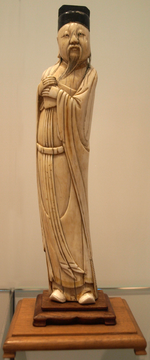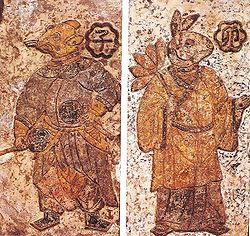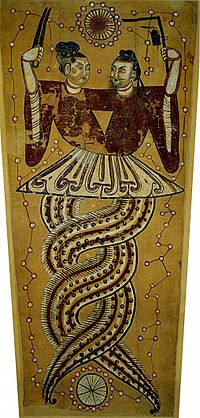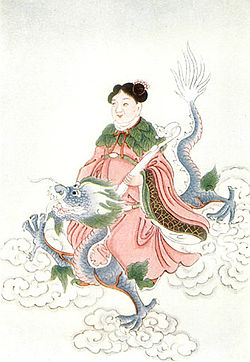- Chinese mythology
-
 "Nine Dragons" handscroll section, by Chen Rong, 1244 CE, Chinese Song Dynasty, Museum of Fine Arts, Boston
"Nine Dragons" handscroll section, by Chen Rong, 1244 CE, Chinese Song Dynasty, Museum of Fine Arts, Boston
Chinese mythology (中國神話) is a collection of cultural history, folktales, and religions that have been passed down in oral or written tradition. These include creation myths and legends and myths concerning the founding of Chinese culture and the Chinese state. Like many mythologies, it has in the past been believed to be, at least in part, a factual recording of history.
Historians have conjectured that the Chinese mythology began in the 12th century BCE. The myths and legends were passed down in oral form for over a thousand years, before being written in books such as Shan Hai Jing. Other myths continued to be passed down through oral traditions like theater and song, before being recorded as novels such as Hei'an Zhuan - Epic of Darkness (literally Epic of the Darkness). This collection of epic legends is preserved by a community of Chinese Han nationality, inhabitants of the Shennongjia mountain area in Hubei, and contains accounts from the birth of Pangu up to the historical era.
Imperial historical documents and philosophical canons such as Shangshu, Shiji, Liji, Lüshi Chunqiu, and others, all contain Chinese myths.
Contents
Major concepts
Some myths survive in theatrical or literary formats, as plays or novels. Important mythological fiction which is seen as definitive records of these myths include:
- Verse poetry of ancient states such as Lisao, Jiu Ge and the Heavenly Questions, by Qu Yuan of the Chu state.
- Fengshen Bang (封神榜), or Investiture of the Gods, a mythological fiction dealing with the founding of the Zhou dynasty.
- Journey to the West, by Wu Cheng'en and published in the 1590s, a fictionalised account of the pilgrimage of Xuanzang to India to obtain Buddhist religious texts, in which the pilgrims encounter ghosts, monsters, and demons as well as the Flaming Mountains.
- Baishe Zhuan, a romantic tale set in Hangzhou involving a female snake who attained human form and fell in love with a man.
The concept of a principal or presiding deity has fluctuated over time in Chinse mythology. Some examples include:
- Shangdi (上帝), appears as early as the Shang Dynasty; also appears as Huangtian Dadi 皇天大帝, but more commonly in later eras as 皇天上帝, (the dating of these occurrences depends on the date of Oracle Bones and the Shujing, aka "Book of Documents"). When Huangtian Dadi was used it refers to Jade Emperor or Yu Huang, and Tian 天 and Jade Emperor were synonymous in Chinese prayers.
- Yu Di (玉皇 or 玉帝 or Jade Emperor), appears in literature after the establishment of Taoism in China, but the position of Yu Huang dates back to beyond the times of Huangdi, Nuwa or Fuxi.
- Tian (天, or Heaven), appears in literature probably about 700 BC, or earlier (the dating of these occurrences depends on the date of the Shujing, aka "Book of Documents"). There are no "creation" oriented narratives for 'Heaven', although the role of a creator is a possible interpreatation. The qualities of 'Heaven' and Shangdi appear to merge in later literature (and are worshiped as one entity ("皇天上帝") in, for example, the Temple of Heaven in Beijing). The extent of the distinction (if any) between them is debated. The sinologist Herrlee Creel proposes that an analysis of the Shang oracle bones shows Shangdi preceded 'tian' as a deity, and that Zhou Dynasty authors replaced the term Shangdi with tian to cement the claim of their influence.
- Nüwa (女媧), appears in literature no earlier than about 350 BC. Her companion was Fuxi (伏羲), the brother and husband of Nuwa. These two beings are sometimes worshiped as the ultimate ancestor of all humankind. They sometimes believe that Nuwa molded humans from clay for companionship. They are often represented as half-snake, half-human creatures. Nüwa was also responsible for repairing the sky after Gong Gong damaged the pillar supporting the heavens (see below).
- Pangu (盤古), written about 200 AD by the Taoist author Xu Zheng, was a later myth claiming to describe the first sentient being and creator.
Time periods
Three August Ones and Five Emperors
Main article: Three August Ones and Five EmperorsDuring or following the age of Nuwa and Fuxi came the age of the Three August Ones and Five Emperors (三皇五帝). These legendary rulers ruled between c. 2850 BC to 2205 BC, before the Xia dynasty.
The list of names comprising the Three August Ones and Five Emperors vary widely among sources (see Three August Ones and Five Emperors for other versions). The most widely circulated and popular version is:
- The Three August Ones (Huang):
- Fuxi (伏羲) - The companion of Nuwa.
- Shennong (神農) - Shennong, "Divine Farmer", reputedly taught the ancients agriculture and medicine.
- Huangdi (黃帝) - Huangdi, "Huang Emperor"(normally "黄" means "yellow", but not here. See below for the full explanation of "皇帝"), is often regarded as the first sovereign of the Chinese nation.
(Source: Shangshu (尚書))
- The Five Emperors (Di):
- Shaohao (少昊) - Leader of the Dongyi "Eastern Barbarians". His pyramidal tomb is in present-day Shandong.[clarification needed]
- Zhuanxu (顓頊) - Grandson of the Huang Emperor.
- Emperor Ku (帝嚳) - Great grandson of the Huang Emperor; nephew of Zhuanxu.
- Yao (堯) - The son of Ku. His elder brother succeeded Ku, but abdicated when he was found to be an ineffective ruler.
- Shun (舜) - Yao, passing over his own son, made Shun his successor because of Shun's ability and morality.
These rulers are generally regarded as morally upright and benevolent rulers, examples to be emulated by latter day kings and emperors. When Qin Shi Huang united China in 221 BC, he felt that his achievements had surpassed those of all the rulers who had gone before him. He combined the ancient titles of Huang (皇) and Di (帝) to create a new title, Huangdi (皇帝), usually translated as Emperor.
Great Flood
Main article: Yu the GreatShun passed his place as leader of the Huaxia tribe to Yu the Great (禹). The Yellow River is prone to flooding, and erupted in a huge flood in the time of Yao. Yu's father, Gun, was put in charge of flood control by Yao, but failed to alleviate the problem after 9 years. He was executed by Shun, and Yu took his father's place, and led the people in building canals and levees. After thirteen years of toil, flooding problems were ameliorated under Yu's command. Shun enfeoffed Yu in the place of Xia, in present-day Wan County in Henan. Upon his death, Shun passed the leadership to Yu. The main source for the story of Yu and the Great Flood comes from The Counsels of Yu the Great in the Classic of History (尚書·大禹謨). As a result of his achievement in resolving the Great Flood, Yu, alone among the mythological rulers, is usually called "Yu the Great" (大禹). Alternatively, he is called Emperor Yu (帝禹), like his predecessors.
Xia Dynasty
Main article: Xia DynastyUpon Yu's death, his position as leader was passed not to his deputy, but to his son Qi. Sources differ regarding the process by which Qi rose to this position. Most versions agree that, Yu designated his deputy, Gaotao (皋陶), to be his successor. When Gaotao died before him, Yu then selected Gaotao's son, Bo Yi (伯益) as successor. One version says that all the peoples who had submitted to Yu admired Qi more than Bo Yi, and Yu passed power to Qi instead. Another version holds that Bo Yi ceremoniously offered the position to Qi, who accepted, against convention, because he had the support of other leaders. Yet another version says that Qi killed Bo Yi and usurped his position as leader.
The version currently most accepted in China has Yu name Bo Yi as successor, because Bo Yi had achieved fame by teaching the People to drive animals with fire during the hunts. Bo Yi had the support of the People and Yu could not stand against it easily. But Yu gave Bo Yi title without power. Yu gave his own son all power to manage the country. After a few fruitless years, Bo Yi lost popularity, and Yu's son Qi became more popular. Then Yu named Qi as successor. Bo Yi, did not go willingly and challenged Qi for the leadership. A civil war ensued. Qi, with strong support from the People, defeated Bo Yi's forces, killed Bo Yi, and solidified his rule.
Qi's succession broke the previous convention of meritorious succession, and began what is traditionally regarded as the first dynasty of Chinese history. The dynasty is called "Xia" after Yu's centre of power.
The Xia Dynasty is semi-mythological. The Records of the Grand Historian and the Bamboo Annals record the names of 17 kings of the Xia Dynasty. However, there is no conclusive archaeological evidence of its capital or its existence as a state of any significant size. Some archaeological evidence for a significant urban civilization prior to the Shang Dynasty does now exist.
Shang Dynasty
Main article: Shang DynastyJie, the last king of the Xia Dynasty, was supposedly a bloodthirsty despot. Tang of Shang, a tribal leader, revolted against Xia rule and eventually overthrew Jie, establishing the Shang Dynasty, based in Anyang. Book 5 of Mozi described the end of the Xia dynasty and the beginning of the Shang dynasty. During the reign of King Jie of Xia, there was a great climactic change. The paths of the sun and moon were different, the seasons were confused and the five grains dried up. Ghouls were crying in the country and cranes shrieked for ten nights. Heaven ordered Shang Tang to receive the heavenly commission from the Xia dynasty. The Xia dynasty has failed morally and Heaven has determined her end. Therefore, Shang Tang was commanded to destroy Xia with the promise of Heaven's help. In the dark, Heaven destroyed the fortress' pool. Shang Tang then gained victory easily.[1]
The Shang Dynasty ruled from ca. 1766 BC to ca. 1050 BC. It came to an end when the last despotic ruler, Zhou of Shang, was overthrown by the new Zhou Dynasty. The end of the Shang Dynasty and the establishment of the Zhou is the subject of the influential mythological fiction, Investitute of the Gods (封神榜). Book 5 of Mozi also described the shift. During the reign of Shang Zhou, Heaven could not endure his morality and his neglect of timely sacrifices. It rained mud for ten days and nights, the nine cauldrons (presumably used in either astronomy or to measure earth movements) shifted positions, pontianaks appeared and ghosts cried at night. There were women who became men, the heaven rained flesh and thorny brambles covered the national highways. A red bird brought a message "Heaven decrees King Wen of Zhou to punish Yin and possess its empire". The Yellow River formed charts and the earth brought forth mythical horses. When King Wu became king, three gods appeared to him in a dream, telling him that they have drowned Shang Zhou in wine and that King Wu was to attack him. On the way back from victory, the heavens gave him the emblem of a yellow bird.
Unlike the preceding Xia Dynasty, there is clear archaeological evidence of a government centre at Yinxu in Anyang, and of an urban civilization in the Shang Dynasty. However, the chronology of the first three dynasties remains an area of active research and controversy.
Creation and the Pantheon
The Jade Emperor is charged with running of the three realms: heaven, hell and that of the living. The Jade Emperor adjudicates and metes out rewards and remedies to actions of saints, the living and the deceased according to a merit system loosely called the Jade Principles Golden Script (玉律金篇, see external links). When judgments proposed were objected to, usually by other saints, the administration would occasionally resort to the counsels of the advisory elders.
Dragon
The Chinese dragon is one of the most important mythical creatures in Chinese mythology. The Chinese dragon is considered to be the most powerful and divine creature and is believed to be the controller of all waters. The dragon symbolised great power and was very supportive of heroes and gods. One of the most famous dragons in Chinese mythology is Yinglong "Responding Dragon", said to be the god of rain. Many people in different places pray to Yinglong in order to receive rain. In Chinese mythology, dragons are believed to be able to create clouds with their breath. Chinese people sometimes use the term "Descendants of the Dragon" as a sign of their ethnic identity.
For the most part, Chinese myths involve moral issues which inform people of their culture and values.
Religion and mythology
There has been extensive interaction between Chinese mythology and the major belief systems of Confucianism, Taoism, and Buddhism. (see Religion in China)
On the one hand, elements of pre-Han dynasty mythologies such as those in Shan Hai Jing were adapted into these belief systems as they developed (in the case of Taoism), or were assimilated into Chinese culture (in the case of Buddhism). On the other hand, elements from the teachings and beliefs of these systems became incorporated into Chinese mythology. For example, the Taoist belief of a spiritual paradise became incorporated into mythology, as the place where immortals and deities dwell.
Important mythologies and deities
 Wen Chang, Chinese God of Literature, carved in ivory, c. 1550–1644, Ming Dynasty.
Wen Chang, Chinese God of Literature, carved in ivory, c. 1550–1644, Ming Dynasty.
- Three Pure Ones (三清) the Daoist trinity, beings first transformed from the primordial unity
- Yuanshi Tianzun (元始天尊)
- Lingbao Tianzun (靈寶天尊)
- Daode Tianzun (道德天尊)
- Four Emperors (四御) heavenly kings of Daoist religion
- Yu Huang (Jade Emperor)
- Beiji Dadi
- Tianhuang Dadi
- Empress of Earth
- Eight Immortals (八仙)
- He Xiangu (何仙姑)
- Cao Guojiu (曹國舅)
- Tie Guaili (鐵拐李)
- Lan Caihe (藍采和)
- Lu Dongbin (呂洞賓)
- Han Xiangzi (韓湘子)
- Zhang Guolao (張果老)
- Han Zhongli (漢鍾離)
- Deities with Buddhist Appellations
- Guan Yin (觀音) (觀音菩薩, also Kuan Yin)
- Laughing Buddha
- Dizang (地藏菩薩/地藏王), ruler of the ten hells
- Four Heavenly Kings (四大天王) Four Buddhist guardian gods
- Gautama Buddha (釋迦牟尼)
- Xi Wangmu (西王母). Queen Mother of the West
- Erlang Shen (二郎神)
- Lei Gong (雷公) god of thunder
- Nezha (哪吒)
- Guan Yu (關聖帝君), God of Brotherhoods. God of martial power. Also revered as God of War.
- Zhao Gongming (趙公明)
- Bi Gan (比干)
- Bi Fang
- Kui Xing (魁星)
- Sun Wukong (孫悟空)
- Daoji (道濟)
- Matsu (媽祖)
- Zao Jun (灶君)
- Tu Di Gong (土地公)
- Town god (城隍)
- Zhong Kui (鍾馗)
- Lung Mo (龍母)
- Hung Shing (洪聖)
- Tam Kung
- Wong Tai Sin (黃大仙)
- Meng Po (孟婆)
- Three August Ones and Five Emperors (三皇五帝), a collection of legendary rulers
- Zhu Rong (祝融):
- Gong Gong (共工):
- Chi You (蚩尤 chi1 you2)
- Da Yu (大禹)
- Kua Fu (夸父追日)
- Cangjie (倉頡)
- Hou Yi (后羿 hou4 yi4)
- Chang E (嫦娥)
- The Cowherd and Weaver Girl (牛郎織女)
- Han Ba (旱魃)
- Wenchang Wang (文昌王)
- Gao Yao (皋陶)
- Tu Er Shen (兔兒神)
- Wu Gang (吳剛)
- Jum sum (枕神)
- Xiang River goddesses (Xiangfei) (湘妃 ), they were: Ehuang (娥皇) and Nüying (女英).
 Zoomorphic guardian spirits of Day and Night, Han Dynasty (202 BC - 220 AD) Chinese paintings on ceramic tile
Zoomorphic guardian spirits of Day and Night, Han Dynasty (202 BC - 220 AD) Chinese paintings on ceramic tile
Mythical creatures
- Bashe a snake reputed to swallow elephants
- Birds:
- Fenghuang (Chinese Phoenix)
- Jian (鶼 jian1) A mythical bird supposed to have only one eye and one wing: 鶼鶼 a pair of such birds dependent on each other, inseparable, hence, represent husband and wife.
- Jiguang (吉光 jíguāng)
- Jingwei (精衛) a mythical bird which tries to fill up the ocean with twigs and pebbles.
- Jiufeng A nine headed bird used to scare children.
- Peng (鵬, a mythical bird of giant size and awesome flying power) Also known as the Chinese roc.
- Qing Niao (青鳥 qīngniâo) a mythical bird, the messenger of Xi Wangmu.
- Sanzuniao (三足鳥) a three-legged crow. Represented the sun birds shot down by Houyi.
- Shang-Yang (a rainbird)
- Su Shuang (鷫鷞 su4shuang3) a mythical bird, also variously described as a water bird, like the crane.
- Zhen (鴆) a poisonous bird
- Zhu[disambiguation needed
 ] (a bad omen)
] (a bad omen)
- Chinese dragon
- Yinglong, a powerful servant of Huangdi.
- Dragon King the king of the dragons
- Fucanglong, the treasure dragon
- Shenlong, the rain dragon
- Dilong, the earth dragon
- Tianlong, the celestial dragon
- Chi, a hornless dragon or mountain demon
- Jiaolong, a dragon of floods and the sea.
- Chinese Beasts[disambiguation needed
 ]
]
- Qilin - a chimeric animal with several variations. The first giraffe sent as a gift to a Chinese emperor was believed to be the Qilin. An early Chinese painting depicts this giraffe replete with the fish scales of the Qilin. In legend, it is believed to have perfect good will, gentleness and benevolence to all righteous creatures.
- Xiezhi (獬豸) - Also called Xie Cai, is a creature of justice said to be able to tell lies from truths. It has a single long straight horn that it uses to gore liars.
- Bai Ze (白澤) - literally meaning "white marsh", is a legendary creature said to have been encountered by the Yellow Emperor and to have given him a compendium listing all the demons in the world.
- Xiniu (犀牛) - or the rhinoceros, started to become mythical creatures when they became extinct in China. Their depictions changed to a more bovine appearance with a single short curved horn on its head that was used to communicate with the sky.
- The Four Symbols (四象)
- Qīng Lóng, Azure dragon of the east.
- Xuán Wǔ, black tortoise of the north.
- Bái Hǔ, white tiger of the west.
- Zhū Què, vermilion bird of the south.
- The Four Fiends (四凶):
- Longma (龍馬), the "dragon horse", similar to the Qilin.
- Kui 夔, a one-legged mountain demon or dragon, also Shun's musical master who invented music and dance.
- Kun, also known as Peng (鯤 kun1) a mythical giant monstrous fish.
- Jiang Shi
- Luduan can detect truth.
- Yaoguai — demons.
- Huli jing — fox spirits.
- Nian, the beast
- Ox-Head and Horse-Face 牛頭馬面 devils in animal forms.[2]
- Pixiu (貔貅)
- Rui Shi (瑞獅)
- Xiao[disambiguation needed
 ] (魈 xiao1) A mythical mountain spirit or demon.
] (魈 xiao1) A mythical mountain spirit or demon. - The Xing Tian (刑天 "punished one" or "he who was punished by heaven") is a headless giant. He was decapitated by the Yellow Emperor as punishment for challenging him. His face is in his torso because he has no head. He wanders around fields and roads and is often depicted carrying a shield and an axe and doing a fierce war dance.
- Chinese Monkey Warded off evil spirits and was highly respected and loved by all Chinese people.
- Yifan Zhang - Cat goddess, led a legion of cats to uphold righteousness before the Shang Era. Descendant of Huangdi.
- Zhayu (詐窳) - a creature of pure yin said to devour evil humans.
- Iphot - a creature of light that brings light to the universe
There are also many other creatures.[3][4]
Mythical places
- Xuanpu (玄圃 xuan2pu3), a mythical fairyland on Kunlun Mountain (崑崙).
- Yaochi (瑤池 yao2chi2), abode of immortals where Xi Wang Mu lives.
- Fusang (扶桑 fu2sang1), a mythical island, interpreted as Japan.
- Queqiao (鵲橋 que4qiao2) the bridge formed by birds across the Milky Way.
- Penglai (蓬萊 peng2lai2) the paradise, a fabled Fairy Isle on the China Sea.
- Longmen (龍門 long2men2) the dragon gate where a carp can transform into a dragon.
- Di Yu (地獄 di4yu4), Chinese term for hell.
Literary sources of Chinese mythology
- Zhiguai (誌怪), a literary genre that deals with strange (mostly supernatural) events and stories
- In Search of the Supernatural (搜神記), 4th century compilation of stories and hearsay concerning spirits, ghosts and supernatural phenomena
- Strange Tales from a Chinese Studio, by Pu Songling, with many stories of fox demons
- Imperial historical documents and confucian canons such as Shiji, Lüshi Chunqiu, Liji, Shangshu
- Zǐbùyǔ (子不語), a collection of supernatural stories compiled during the Qing Dynasty
See also
- Chinese creation myth
- Chinese astrology
- Chinese folk religion
- Chinese spiritual world concepts
- List of deities
- I Ching
- Ba gua
- Buddhist mythology
- Celestial bureaucracy
- Chinese mythology in popular culture
- Great Flood (China)
References
- ^ http://ctext.org/mozi/condemnation-of-offensive-war-iii
- ^ Wenlin Software for Learning Chinese, Version 3.4, Wenlin Institute http://www.wenlin.com
- ^ 中国古代异物大汇总
- ^ 中國最全的古代異物、怪物簡介
- Werner, E. T. C. (1922). Myths & Legends of China. New York: George G. Harrap & Co. Ltd.. http://www.gutenberg.org/etext/15250. Retrieved 2007-03-14. (Project Gutenberg eText.)
- Paper, Jordan D. (1995). The Spirits are Drunk: Comparative Approaches to Chinese Religion. Albany, New York: State University of New York Press. ISBN 0791423158.
External links
- Chinese mythology at Godchecker
- Many Chinese myths online
- Taoist Images - A collection of Chinese Mythology Images
Chinese mythology Overview topics Major entities Creatures Bixie · Black Tortoise · Azure Dragon · White Tiger · Vermilion Bird · Qilin · Fenghuang · Huli jing · Chinese guardian lions · Píxiū · NiánPlaces Popular literary works Shan Hai Jing · Shi Yi Ji · The Peach Blossom Spring · Fengshen Bang · Legend of the White Snake · Strange Stories from a Chinese Studio · Journey to the West · In Search of the Supernatural · Zi Bu Yu · Tian Xian PeiCategories:- Chinese mythology
- Chinese traditional religion
Wikimedia Foundation. 2010.



